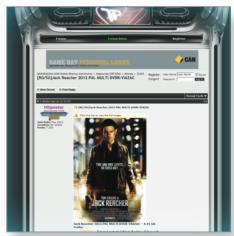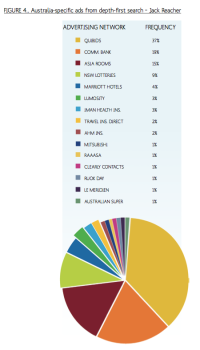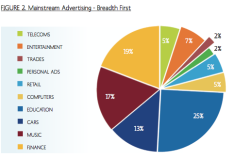Piracy: Study shows 99 per cent of online ads on pirate sites are ‘high-risk’
 A study of the thousands of pages from illegal pirate websites has shown 99 per cent of ads being targeted at Australians were unsafe and broadly fell into the “high-risk” categories of malware, pornography and scam websites.
A study of the thousands of pages from illegal pirate websites has shown 99 per cent of ads being targeted at Australians were unsafe and broadly fell into the “high-risk” categories of malware, pornography and scam websites.
The peer reviewed study conducted by Federation University in Ballarat last year claims to be the first Australian attempt to understand the advertising around illegal websites. Earlier this week Mumbrella revealed many major Australian brands are, mostly inadvertently, pouring millions of dollars into illicit enterprises.
“I’ve looked at Australia and several countries in the Asia-Pacific,” said Paul Watters, professor of information technology. “We often hear about mainstream brands advertising on these sites and my problem with that focus is that it ignores all the other advertising where the scams, sex and so on occur.”
 Watters, who is now with the University of Massey in New Zealand, said the study involved physically analysing the top 500 Google-upheld copyrighted complaints for movies and TV distributed by major Hollywood studios and then analysing 10 sites from each complaint sampled for all ads displayed.
Watters, who is now with the University of Massey in New Zealand, said the study involved physically analysing the top 500 Google-upheld copyrighted complaints for movies and TV distributed by major Hollywood studios and then analysing 10 sites from each complaint sampled for all ads displayed.
While only one per cent of those ads were for mainstream brands the study still identified major Australian brands including the Commonwealth Bank, Australian Super and NSW Lotteries advertising on the website. One of those clients NSW Lotteries were also among the brands found advertising around piracy portal Watchseries.it by Mumbrella this week.
The brand found most likely to appear within the one per cent of “mainstream” ads is for penny auction site Quibids.com, a category the consumer group Choice has issued multiple warnings about.
One of the main explanations of brands found advertising on these pirate websites is retargeting, tracking people who visit a site and displaying the brand’s retargeted ads to them as they visit other sites online.
“We eyeballed all the ads and classified it as either mainstream or high risk,” he said. “In terms of methodology every time we took a new page capture we didn’t store any cookies. There was nothing in a virtual browser which recorded where we had been eliminated that potential for retargeting by Google etc.”
Watters’ study also broke down the types of risks to consumers from the ads, targeted at Australians, on the webpages studies and found of 46.49 per cent were for malicious or suspected malicious code, while 20.18 per cent were for the sex industry. A further 14.91 per cent were for scams of various kinds, including premium rate SMS, investment and employment scams.
The study also showed the categories of mainstream advertisers appearing on these sites, with retailers the most likely to appear, followed by technology and the computer industry then trades and cars.
Watters added: “The risks (for consumers) are if it is a scam site you will lose money, if it is kids they look up Disney on Piratebay they can have hardcore pornography served up to them which is a risk to children and one of my research areas.
“Then you have the brands who are associated with it and it is such a bad look where they are all put on the same page.
“If you are CommBank for example and you are advertising on a page where there is also some malware then that sends completely the wrong messages.”
Earlier this week the major advertisers’ industry body the Australian Association of National Advertisers (AANA) CEO Sunita Gloster reminded the industry they had an obligation to ensure their content was not appearing on these websites.
“The expectation is that big brands act responsibly and do not condone knowingly illegal activity like breach of artistic or commercial copyright by placing advertising around this activity. The heart of this issue is about the associated reputational risk and the significance of this to brand owners,” said Gloster.
“Advertisers, whether they buy direct or via their media agency, need to take a view on this and act accordingly.”
Watters said there was not enough concern coming from both clients or their media agencies, adding: “Many marketing departments are more interested in eyeballs.
“If there is a security or risk department then as far as I’m aware they aren’t even aware of it, and if they were aware they would be very concerned I’m sure.
“It is up to the advertiser to be more responsible and show some interest ”
Nic Christensen





You mean there aren’t nubile women wanting casual sex in my suburb?
I’M OUTRAGED!
User ID not verified.
Adblock. All problems solved.
User ID not verified.
It’s nothing adblockplus doesn’t fix
User ID not verified.
Who the hell clicks on ads while on the internet anyway? Let alone would be dumb enough to click on penis enhancing drugs while on The Pirate Bay?
User ID not verified.
Karl Marx was hardly a model human being, and he got a few things quite wrong, not least of which was Das Kapital.
However, one or two of the things he got right are worth consideration, and this kind of thing is smack bang in the middle of rampant capitalism feeding upon itself and failing to clean up its own shit.
User ID not verified.
Breaking news, water is wet.
User ID not verified.